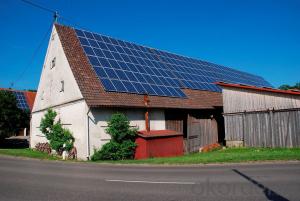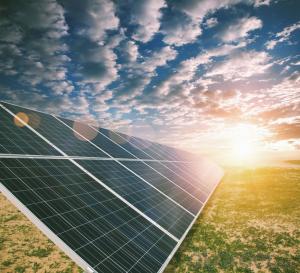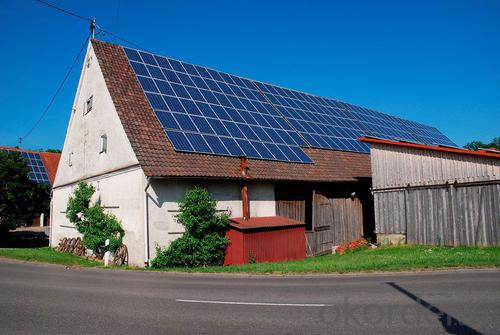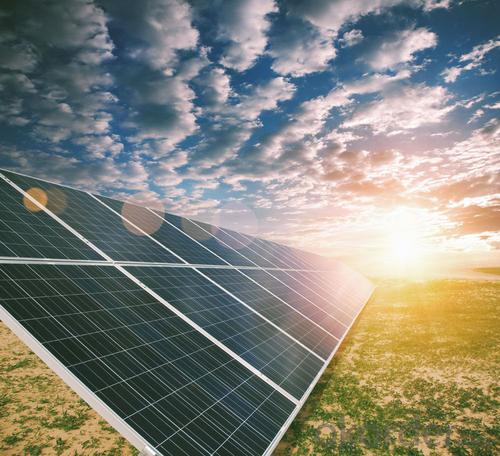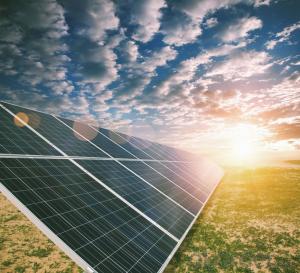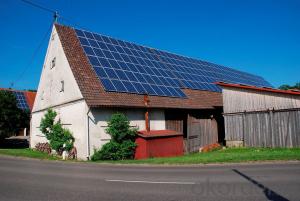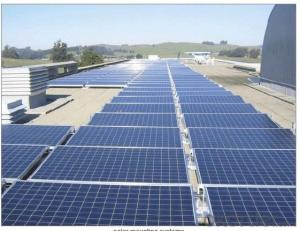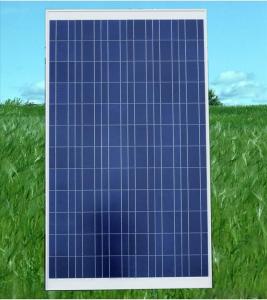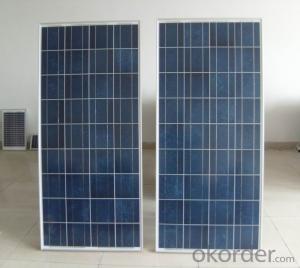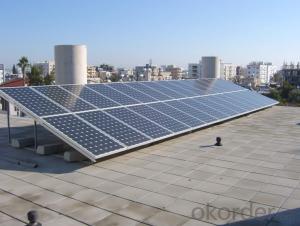Black Friday Solar Panels - 315W Silicon Polycrystalline
- Loading Port:
- Guangzhou
- Payment Terms:
- TT OR LC
- Min Order Qty:
- 200000 watt
- Supply Capability:
- 20000000 watt/month
OKorder Service Pledge
OKorder Financial Service
You Might Also Like
INTRODUCTION
We are a high-tech group wich specializes in solar products design,research, manufacture, sales,solar projects design and installation.
Our national sales service covers seven parts, including northeast, north, east, middle, south, northwest and southwest, international sales covers five continents and over forty countries, including Germany, Italy, Spain, France, America and Brazil etc.
Our present annual capacity is 6 million for wafer, 60MWp for solar cells,200MWp for solar modules and one hundred thousand for solar applications. It is expected that the annual capacity of 2012 will be up to 30 million for wafer, 300MWp for solar cells, 1000MW for solar modules and 2 million for solar applications.
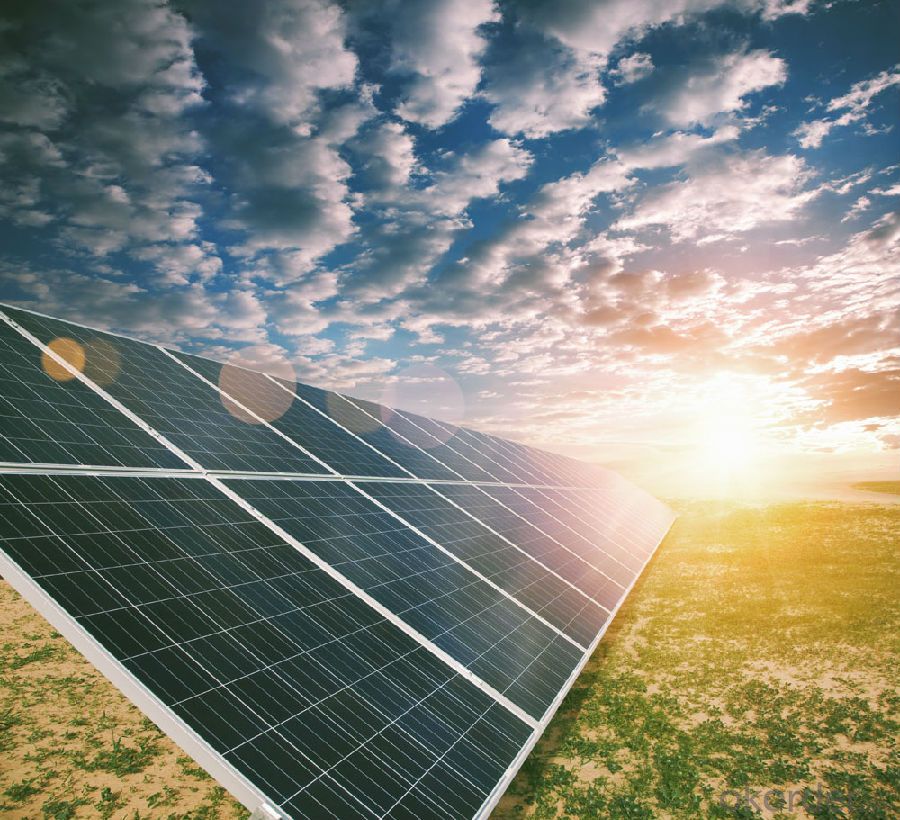
This installation Manual contains essential information for the electrical and mechanical installation that your must know before installing CUSTOMER PV modules. This also contains safety information you need to be familiar with .All the information described in this manual are the intellectual property of CNBM and based on the technologies and experiences that have been acquired and accumulated in the long history of CUSTOMER. This document does not constitute a warranty, expressed or implied.
DATA SHEET
Maximum power | 315W |
Cell type(mm) | Polycrystalline solar cell 156*156 |
Number of cell(pcs) | 72(6*12) |
Manufacture site | China |
Open-circuit voltage(voc) | 45.1V |
Maximum power voltage(vmp) | 37.3V |
Short-circuit current(isc) | 8.88A |
Optimum operating current(imp) | 8.45A |
Power tolerance | 0~+5W |
Module efficiency | 16.2% |
Dimensions(mm) | 1956*992*40 |
Weight | 27 kg |
Backsheet | Silver |
Frame Colar | White |
Frame | Anodized Aluminum Alloy |
FAQ:
1. How long will my inquiry get response?
Your inquiry related to our products or prices will be replied within 24 hours.
2. Can I get professional service and suggestion?
Well-trained and experienced staffs to answer all your questions in fluent English.
3. Do you accept OEM or customized design?
OEM & ODM, any your customized lightings we can help you to design and put into product.
4. What if I need specific design?
Distributorship are offered for your unique design and some our current models.
- Q: I'm re-doing my roof. Is it workable?Can I get a government grant or something to put solar panels on my roof?I know they did something like that for windows.
- solar panels take about 5 to 20 yrs to break even. for the average home
- Q: if u buy solar panels and never take em out of the box for like thirty years will they still work good thirty years after you bought them
- Build okorder /
- Q: What is the difference between Photovoltaic Panels and Solar Panels?
- Dear friend, Photovoltaic Panels and Solar Panels are the same products.
- Q: What would these solar panels power? For instance, my energy bill shows 2035kWh for last month. How much would this remove from that if it outputted full power? Thanks!
- A solar panel that is rated at 60 watts would produce that amount under the most favorable conditions of direct sunlight at noon in a good location. This would taper off to nothing at the beginning and ends of the daylight. A 60 watt Panel operating at full output for hour would produce 60 watt hours. If we assumed a straight line of output from zero to 60 watts and back to 0 again over 6 hours the average output would be 30 watts x 6 hours = 80 watt hours / day x 365 days = 65700 watt hours in a year / 2 = 5475 watt hours in a month. You lose about 0% converting from DC to AC. This reduces this to about 4927.5 watt hours. Your bill is measured in KW hr which are 000 times bigger. This is 4.9275 KW hr or .24% of your last month's bill. At a national average of about $.2 per KW hr the energy out put for one month would be equal to about 60 cents.
- Q: can solar panels have glass between the panels and the sun?
- Should be okay but you might lose a little power if the windows blocks infrared or ultraviolet light [which I believe they do]
- Q: Would it be possible to use a lens or a mirror to focus light onto a solar panel in order to make in more efficient? And is something like this already being used? It was just a thought and I haven't spent much time on it, but I figured I'd ask.
- yes it is being done. i've seen adds for such a system. on the other hand, if you had a 5 sq in Lens focused on a small cell, and a 5 sq in cell, they'd be about the same. in fact, the cell might be a bit better because (A) there wouldn't be any loss in the Lens, and (B) it might be that the solar cell would use some frequencies to which the Lens was opaque. in addition, the cost of solar cells is dropping, making the cost of the mirrors or lenses uneconomical by comparison.
- Q: Can solar panels be used on vehicles?
- Yes, solar panels can be used on vehicles. They can be installed on the roof or the body of the vehicle to harness sunlight and convert it into electrical energy, which can be used to power various systems or charge the vehicle's battery. This technology is commonly used in electric and hybrid vehicles to improve their energy efficiency and reduce their carbon footprint.
- Q: How can solar panels be used for heating water?
- Solar panels can be used for heating water by using the energy from the sun to heat up a fluid, typically water or antifreeze, which then transfers the heat to a storage tank. This heated water can be used for various purposes such as showers, washing dishes, or heating indoor spaces.
- Q: Can solar panels be used for powering wireless charging stations?
- Yes, solar panels can be used to power wireless charging stations. Solar panels convert sunlight into electricity, which can be utilized to charge devices wirelessly through a charging station. This makes it a sustainable and environmentally friendly option for providing power to wireless charging stations.
- Q: Can solar panels be used in areas with high levels of air humidity or moisture?
- Yes, solar panels can be used in areas with high levels of air humidity or moisture. However, it is important to note that excessive moisture can affect the performance of solar panels over time. Therefore, proper installation, regular maintenance, and periodic cleaning are crucial to ensure their efficiency and longevity in such environments.
Send your message to us
Black Friday Solar Panels - 315W Silicon Polycrystalline
- Loading Port:
- Guangzhou
- Payment Terms:
- TT OR LC
- Min Order Qty:
- 200000 watt
- Supply Capability:
- 20000000 watt/month
OKorder Service Pledge
OKorder Financial Service
Similar products
Hot products
Hot Searches
Related keywords
